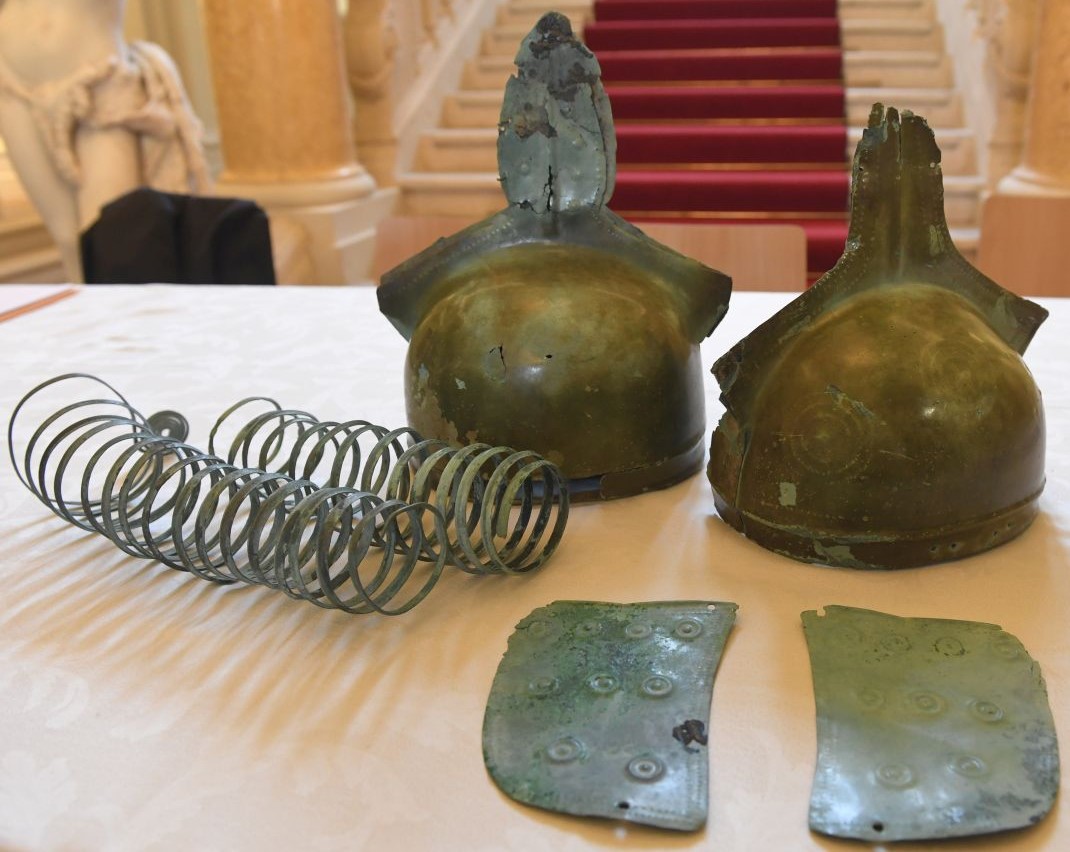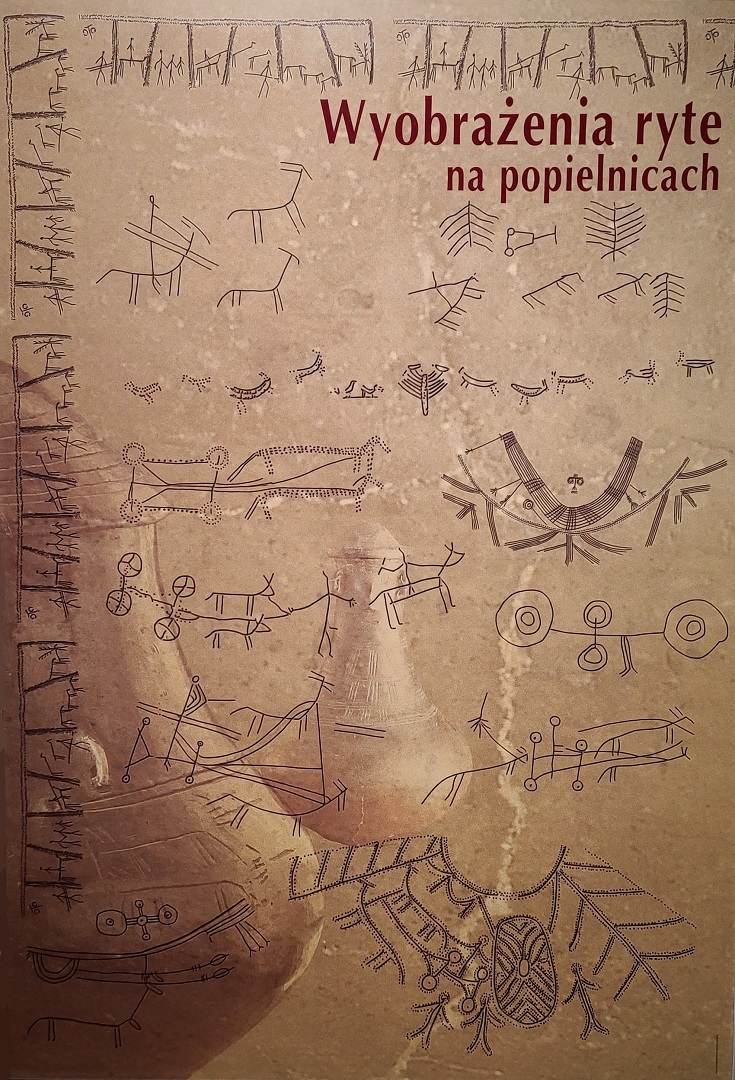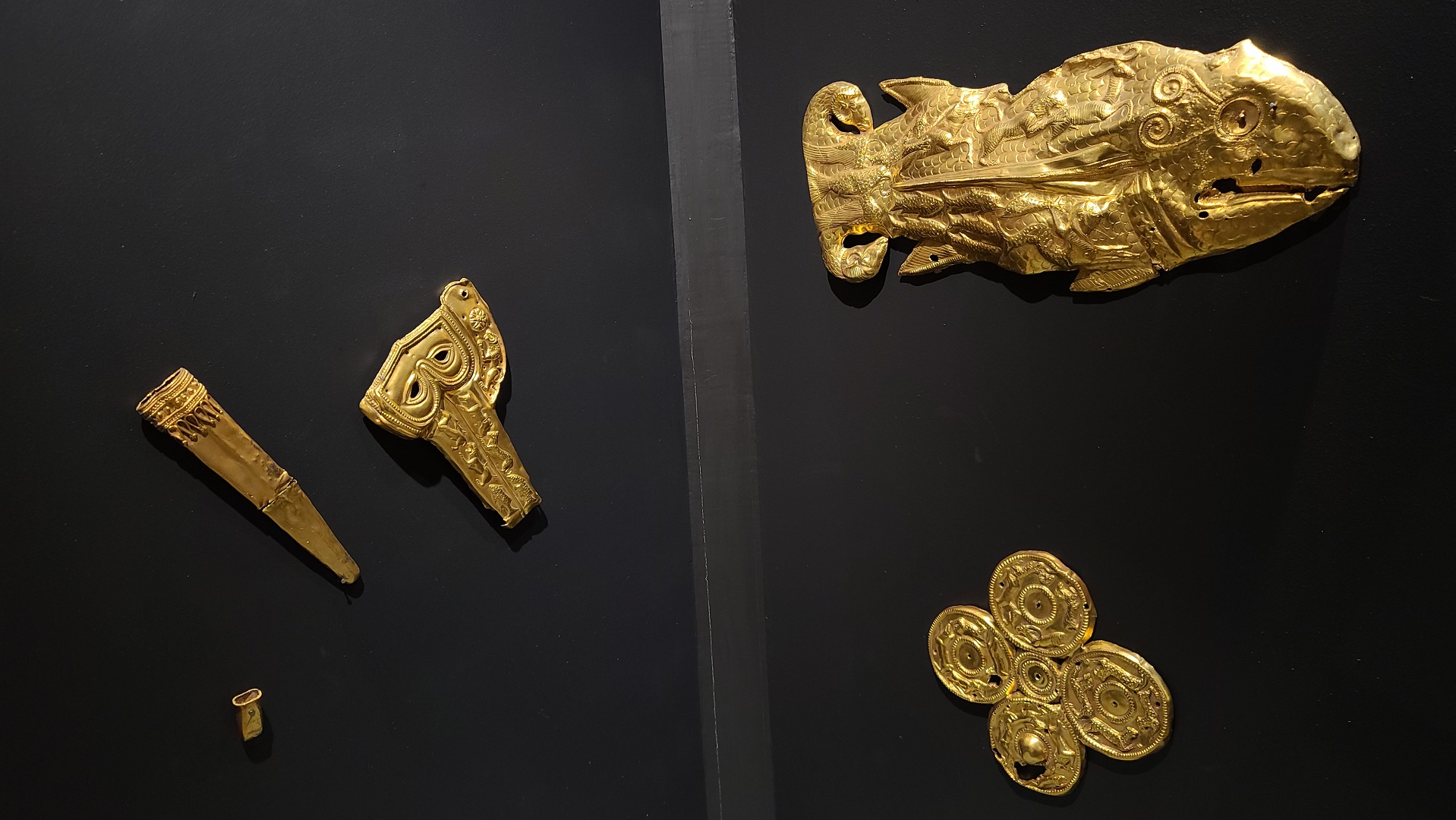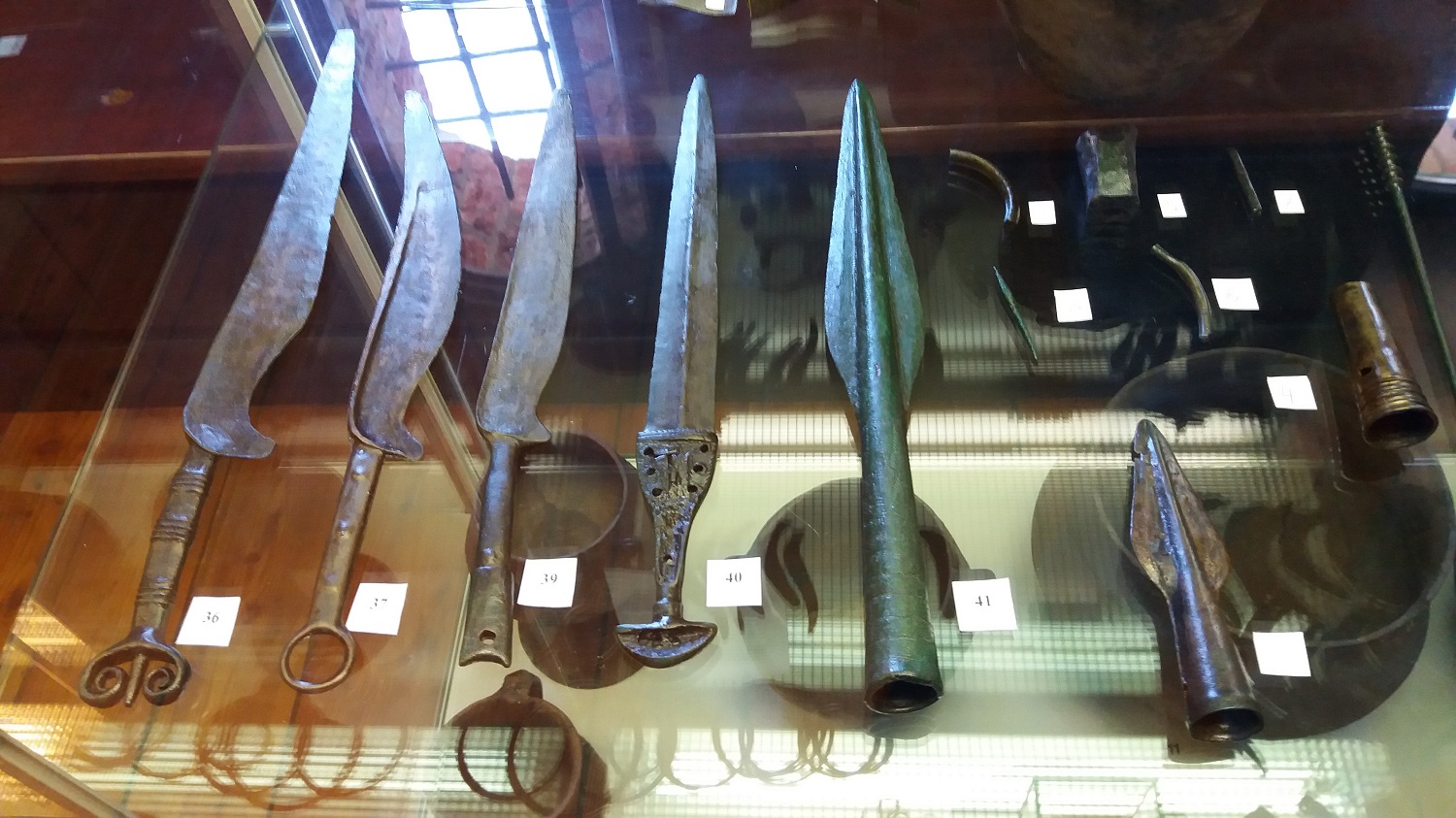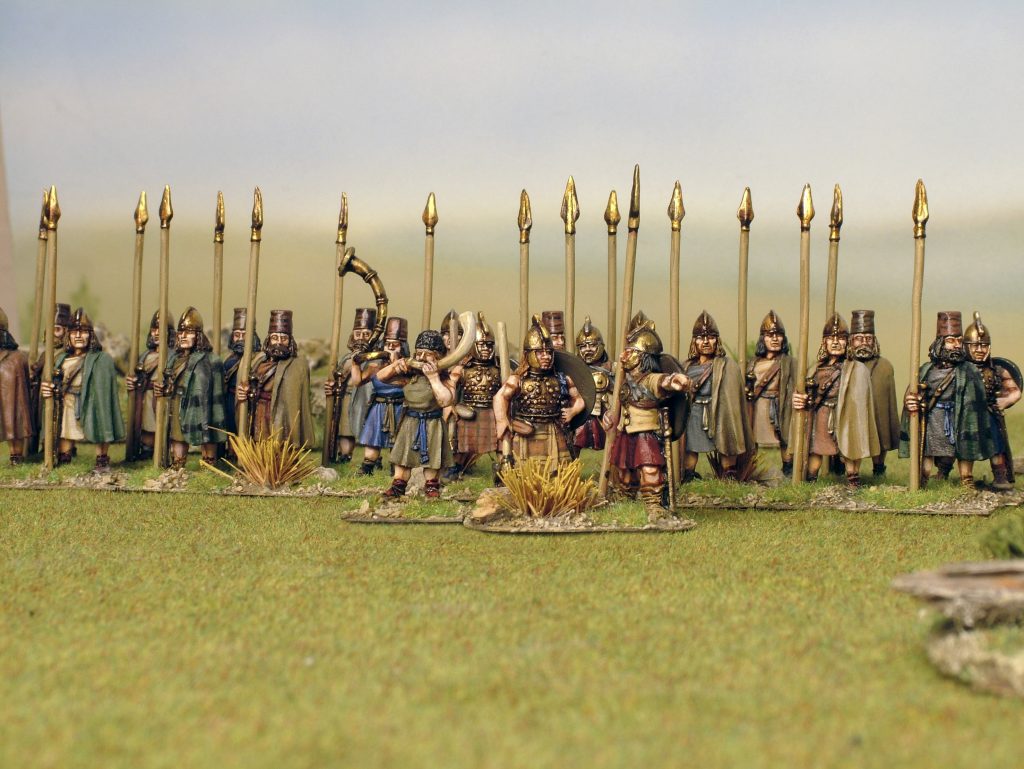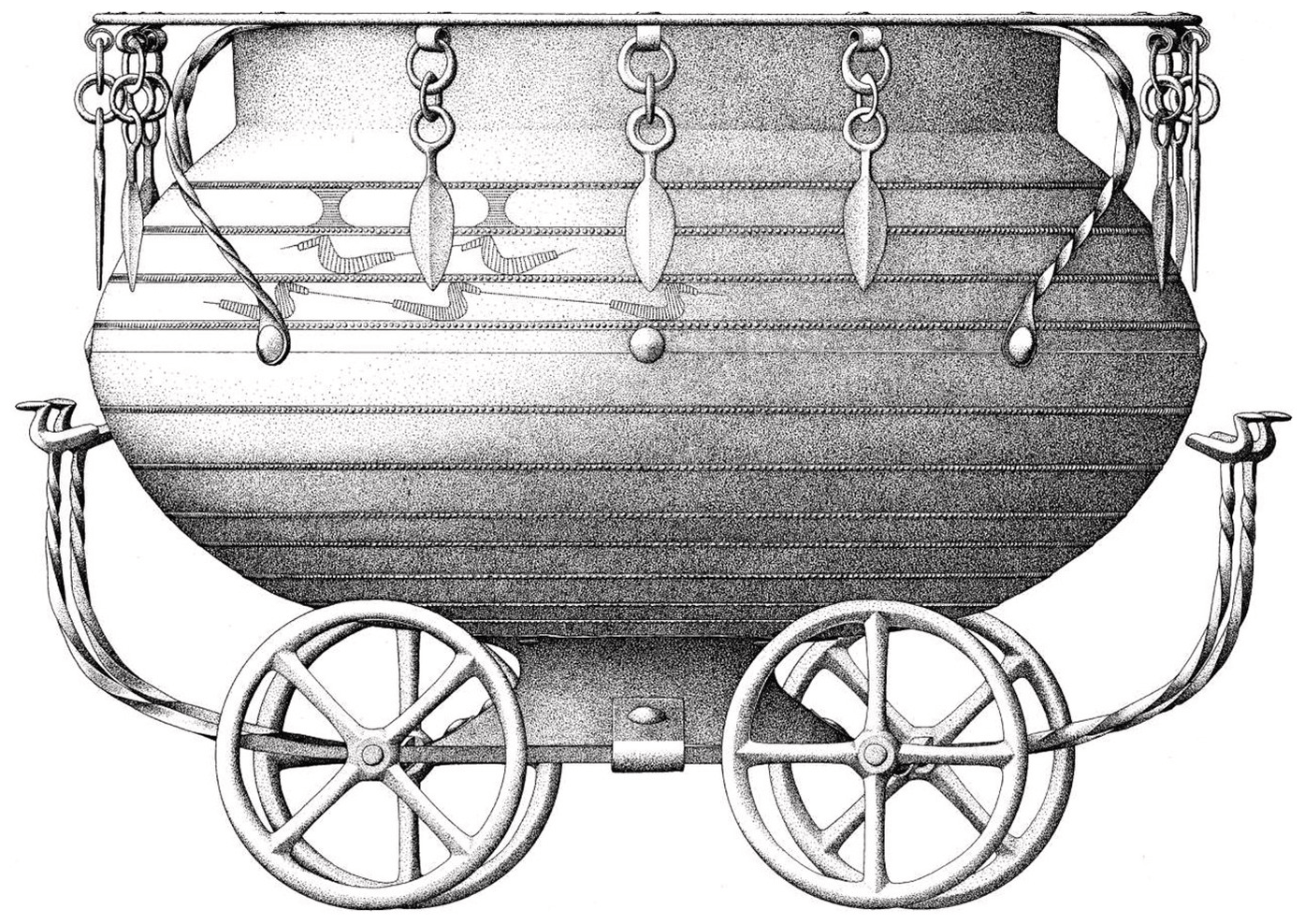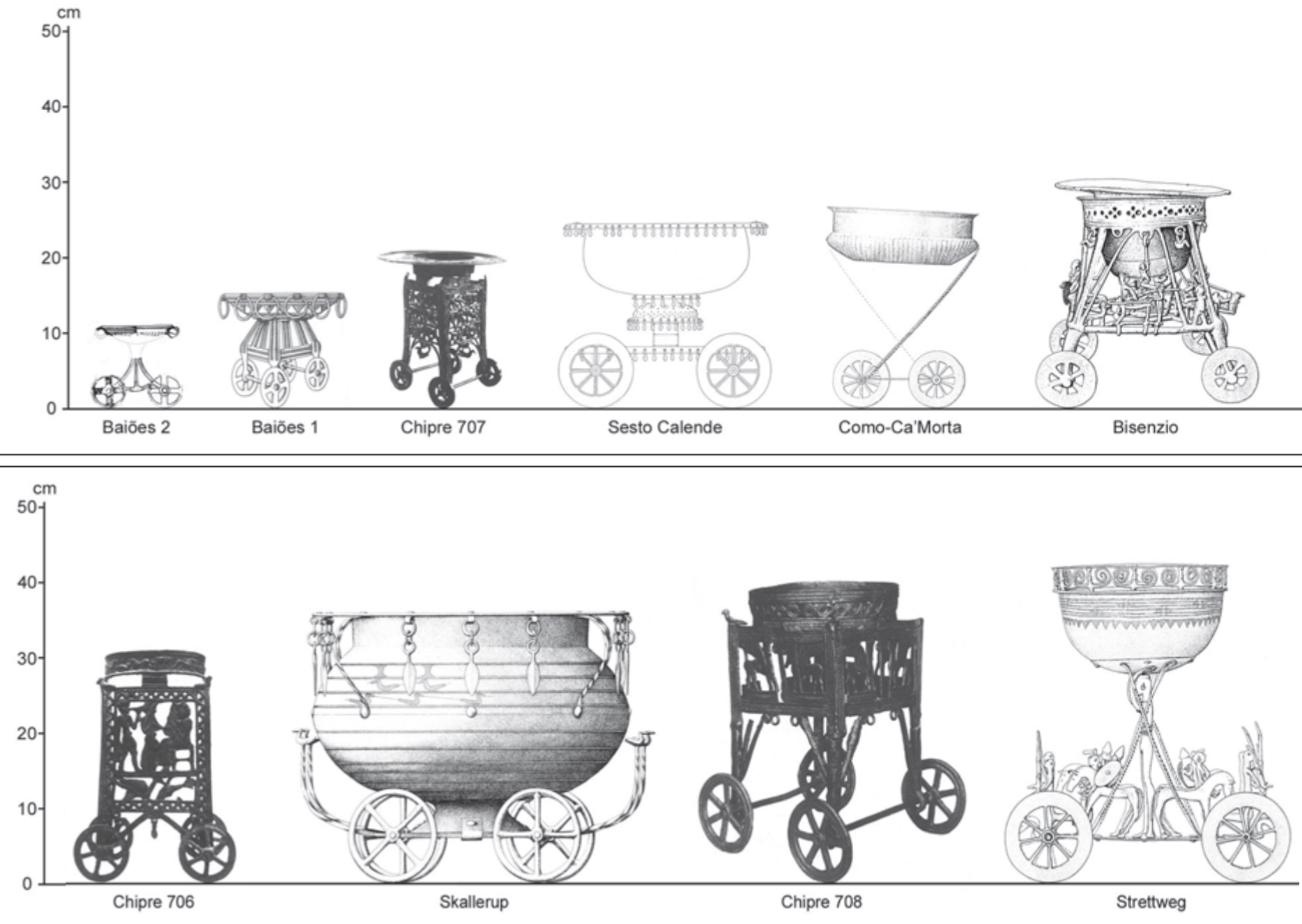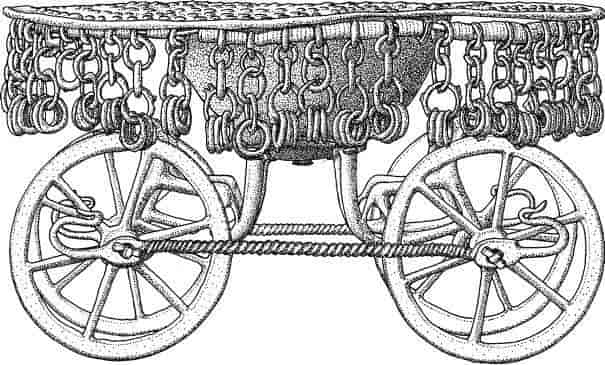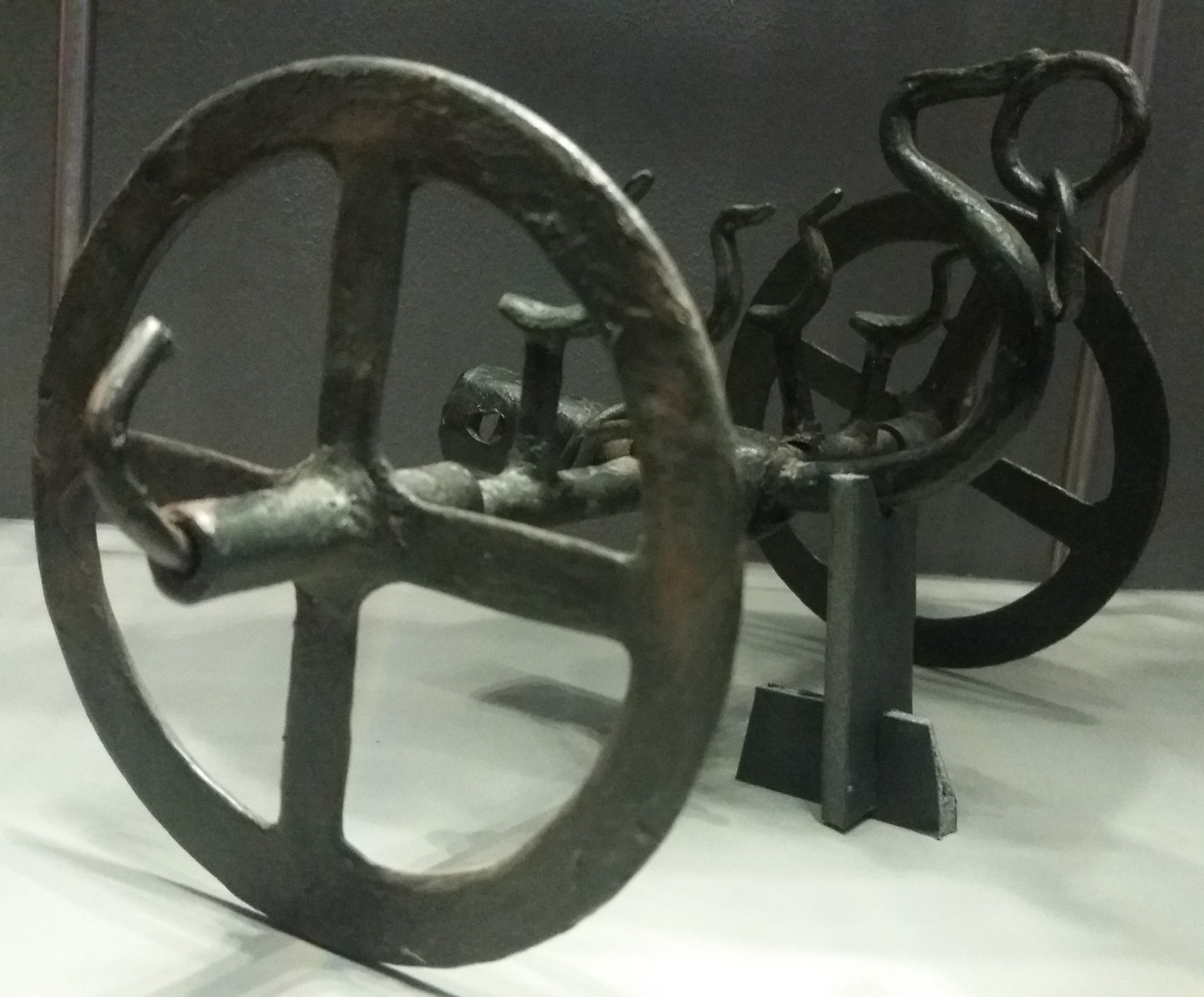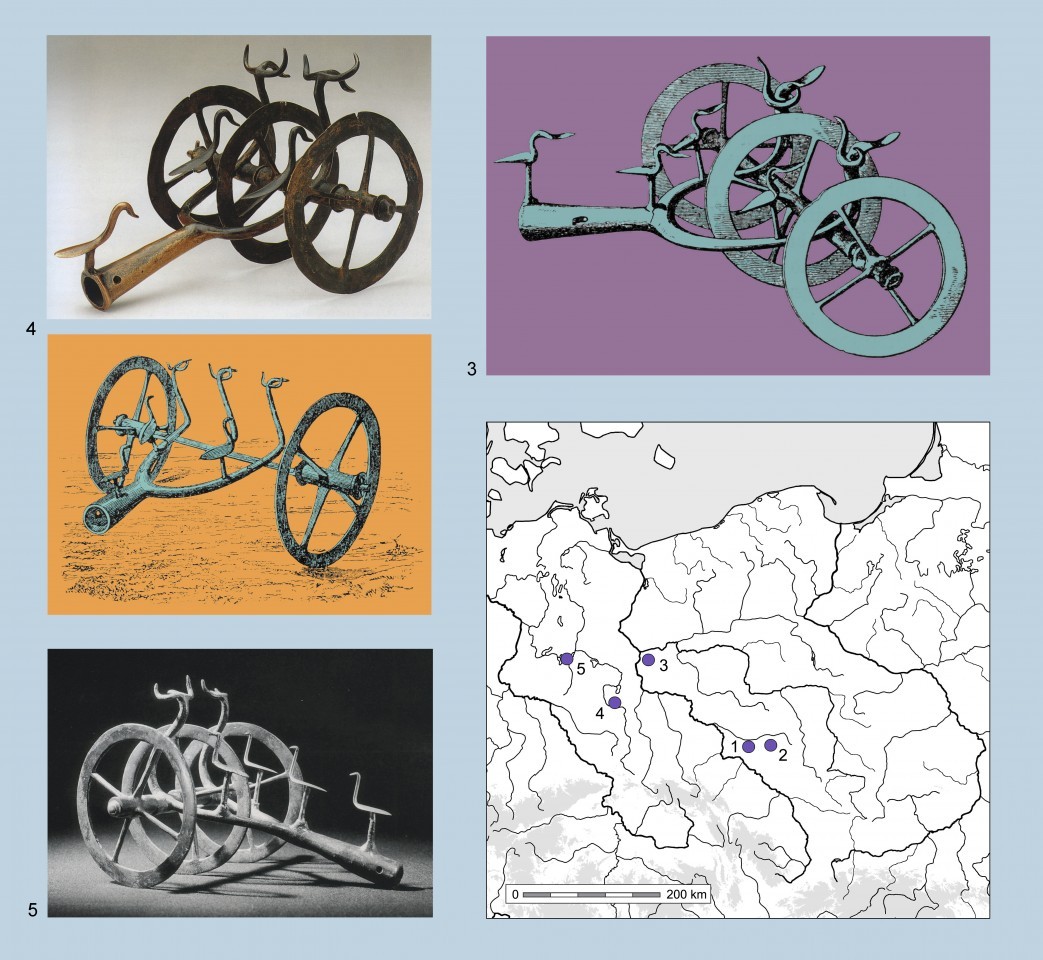Lusatian Culture
This culture existed from 1300 BC to 500 BC in most of what is now Poland and parts of the Czech Republic (mainly Moravia), Slovakia, Eastern Germany (Lusatia) and Western Ukraine. This culture had close contacts with the Nordic Bronze Age, Hallstatt and La Tène cultures.
The Lusatian Culture (Kultura Łużycka) developed as the preceding Trzciniec Culture (1900 BC - 1100 BC) experienced influences from the Tumulus Culture (descendant of the Unetice Culture) of the Middle Bronze Age (1600 BC - 1200 BC), essentially incorporating the local communities into the socio-political network of Iron Age Europe. It formed part of the Urnfield systems found from Eastern France, Southern Germany and Austria to Hungary and the Nordic Bronze Age in Northwestern Germany and Scandinavia.
The population of this culture had a stable, sedentary lifestyle. The settlements were established along the rivers and streams or near lakes and were inhabited for a long time or periodically, depending on the dominant type of economy. Permanent settlements functioned near fertile soils, in places where the trade routes ran in the vicinity of river crossings. There were different types of economy buildings within the settlements: farm buildings, craft workshops and earth cavities that played the role of granaries and waste pits. The basis of the economy of the population of the Lusatian Culture was agriculture and animal husbandry. Women often practiced spinning and weaving. An important field of manufacture was pottery. Hand-made vessels were fired in special ovens.
💀 Burial was by cremation and inhumations were rare. The urn was usually accompanied by numerous (up to 40) secondary vessels. Metal grave gifts are sparse but there are numerous hoards that contain rich metalwork (such as Kopaniewo, Pomerania), both bronze and gold (hoard of Eberswalde, Brandenburg). Graves containing moulds, like at Bataune, Saxony and tuyeres, attest to the production of bronze tools and weapons at the village level. The royal tomb of Seddin, Brandenburg, Germany, covered by a large earthen barrow, contained Mediterranean imports like bronze vessels and glass beads. Cemeteries can be quite large and contain thousands of graves.
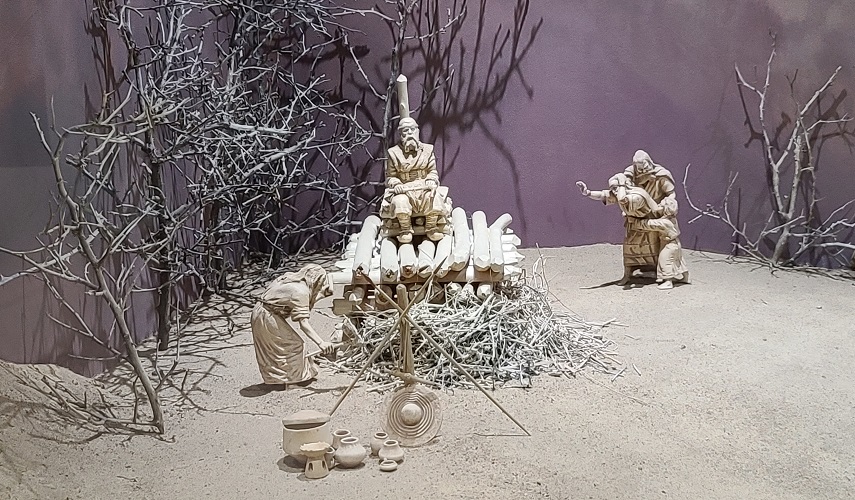
Józef Kostrzewski and Bolko von Richthofen drew attention to the existence of earlier graves, which can be called transitional forms, between the skeletal rite and the cremation rite. These were urnless cremation graves, in which the burnt remains were scattered in pits dug up to the length of the body of the deceased (you could not see an urn inside but ashes in place where human bones should be). Moreover, the presence of certain ceramic and bronze products was indicated both in the early stages of the Lusatian Culture and in the preceding culture. Therefore, it was considered that the taxonomic unit in question was developed at the turn of the 2nd and 3rd Bronze Age, around 1300 BC on the basis of the extension of the previous culture. In 1928 Leon Kozłowski agreeing with this theory, distinguished for the areas of Lower Silesia, Southern Greater Poland, Lusatia and Eastern Saxony, the so-called Old Sorbian Culture, recognizing these lands as the cradle of Lusatian Culture.
The average height of 300 people buried in the Przyborów cemetery between 1300 BC and 700 BC was 160 cm - 164 cm and the average age was 22 years. Many children died before they reached the age of 7 and many males and females before they reached the age of 30[1]. 💀

Lusatian Culture's economy was mainly based on arable agriculture, as is attested by numerous storage pits. Wheat (emmer) and six-row barley formed the basic crops, together with millet, rye and oats, peas, broad beans, lentils, and gold of pleasure (Camelina sativa). Flax was grown, and remains of domesticated apples, pears and plums have been found. Cattle and pigs were the most important domestic animals, followed by sheep, goats, horses and dogs. Pictures on Iron Age urns from Silesia attest horse riding, but horses were used to draw chariots as well. Hunting was practiced, as bones of red and roe deer, boar, bison, elk, hare, fox, and wolf were attested, but it did not provide much of the meat consumed. The numerous frog bones found at Biskupin may indicate that frogs' legs were eaten as well.
Settlements
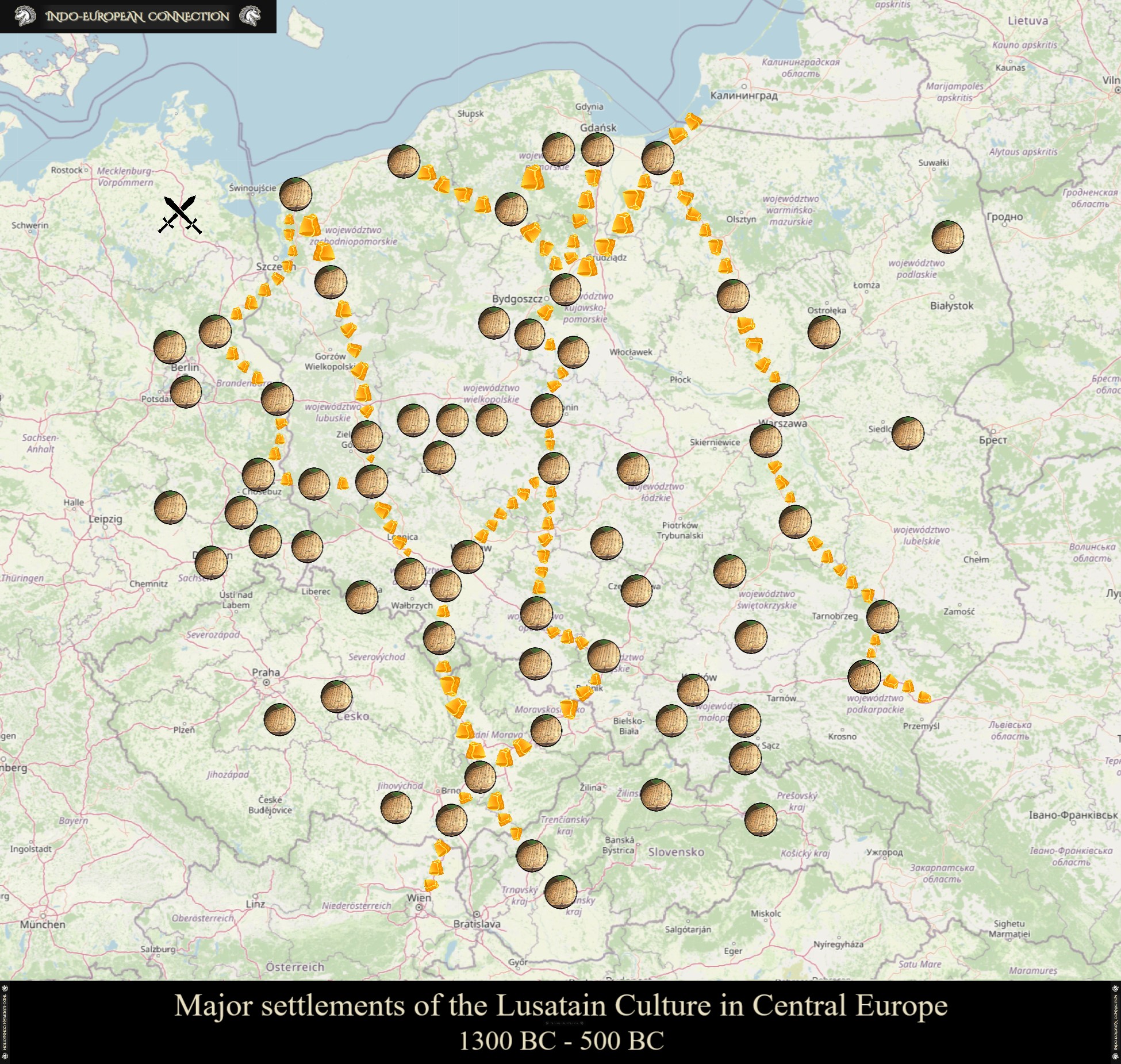
Well-known settlements include Biskupin in Poland, and Buch near Berlin in Germany. Lusatian Culture had both open villages and fortified settlements (burgwall or grod) on hilltops or in swampy areas. The ramparts were constructed of wooden boxes filled with soil or stones. The major settlements were located near the following modern places (all are also portrayed on a map above):
Germany: Buch, Lichterfelde near Berlin, Seddin near Berlin (royal tomb with 3 urns), Frankfurt am Oder, Tornow, Niederkaina, Liebersee, Klein Lieskow, Niederneuendorf, Senftenberg, Dresden-Coschutz, Landeskrone.
Poland: Biskupin, Gzin (also probable place of cannibalism), Sobiejuchy, Izdebno, Żnin, Białołęka near Warsaw, Jatwieź Duża near Suchowola, Kruszwica, Częstochowa, Grzybiany near Legnica, Polanowice, Słupca, Pysznica near Zamość, Wicin, Złota Pinczowska, Maciejowice near Siedlce, Szyszno, Łącko, Nowa Huta, Książek near Kłodzko, Mogilica, Kamień Pomorski, Koszalin, Borki near Goworowo, Radom-Wośniki, Bruszczewo, Lutomiersk near Łódź, Madeły, Charzykowy, Łęki Małe, Piwonice, Kalisz (Calisia), Domasław, Łęgowo near Wągrowiec, Opole, Petrykozy, Lasocin, Łopusznie, Maszkowice, Góra Zyndarma, Głubczyce, Rogalin, Smuszewo, Izdebno Kościelne near Warsaw, Świlcza near Rzeszów, Góra-Orle, Pruszcz Gdański, Uniradze, Mława, Ruda, Różanówka, Nowa Sól, Zakrzów, Łagiewniki, Ślęża, Strzegom, Nadziejowo, Kargowa, Kamieniec, Elbląg.
Czech Republic: Jaroměřice nad Rokytnou, Křepice, Olbramovice, Nezamyslice, Křenovice, Kotouč near Štramberk, Čáslavský Hrádek.
Slovakia: Pobedim, Orava, Tupá Skála, Prašník, Vítkovce, Kostoľany pod Tribečom, Vyšný Kubín.
The first groups of the population of the Lusatian Culture settled in the Opole region at the end of the older period of the Bronze Age, initially in the Głubczycka Upland, later in the vicinity of Opole.
At the time when the fortified settlement in Biskupin was being developed in Kujawy, a rich settlement of the same Lusatian Culture was also developing in Warsaw's Białołęka. In the vicinity of Ostródzka Street, there are also many other archaeological sites, such as the remains of a large Lusatian settlement, 1.5 km north. In addition to the discovery of traces from the Lusatian population, researchers also found traces from other periods including the Trzciniec Culture (1600 BC - 1200 BC) from the early Bronze Age[2].
The first information about excavating a cemetery of the Lusatian Culture in the Wągrowiec area dates from the fifteenth century AD records of Jan Długosz. The chronicler wrote that "born from the womb of the earth are pots, by themselves, only by the art of nature, without any human helping, of all sorts of different shapes, similar to those people use, though delicate and soft, while still rooted in their family soil in the ground, yet when they are removed they become tight and hardened in the sun or wind".
Thousands of kurgans (tumuli) from Lusatian Culture near Nowa Sól and Sława in Poland are nowadays destroyed by the forest workers of Poland and people who steal artifacts (grave robbers). Those graves should be examined by professional archaeologists and dated properly with extensive DNA testing of all discovered human remains.
Gallery Of Artifacts
Vocabulary
Antoine Meillet once wrote in his book "The Indo-European Dialects": Baltic and Slavic show the common trait of never having undergone in the course of their development any sudden systemic upheaval. […] there is no indication of a serious dislocation of any part of the linguistic system at any time. The sound structure has in general remained intact to the present. Baltic and Slavic are consequently the only languages in which certain modern word-forms resemble those reconstructed for Common Indo-European.
By using the comparative method between Sanskrit, Germanic, Greek, Slavic and Baltic languages certain words can be brought up that can be ascribed to the times of the Corded Ware Culture in their origin or even the times of Forest-Steppe Eastern European Hunter-Gatherer Yamnaya population, making them 5000 years old and in the case of Lusatian Culture 3500 years old:
snow - sniog / snieg
sky - nebo
mist - migla
land - land, lan
year - iar
rye - rugis, rugiž, ruž
seed - siemię / siemen
sour, cheese, raw - sūr
honey - miod
fermented - kvass / kvasis
nightmare - mara
coal - angal
Tollense Battle
Situated in the North German plain, 120 km (75 miles) north of Berlin, the Tollense Battle site stretches for several hundred meters on both sides of the small river. Within the plain, the Tollense meanders in a wide valley between marshy meadows and low hills. During the last millennia, the river's course has been only slightly modified[3][4]. As of late 2017, the remains of some 140 Bronze Age men from that site had been identified[5]. Most of these were young men between the ages of 20 and 40, but there were also at least two women identified among 14 skeletons that were genetically tested[6].
Before March 2016, about 10000 human and 1000 animal bones had been found, by March 2018 that number had risen to a total of about 13000 fragments. The total number of dead is estimated between 750 to more than 1000. The total number of fighters might have ranged between 3000 and more than 5000, assuming a casualty rate of 20% - 25%[5]. In one spot, 1478 bones were found within just 12 m² (130 sq ft), potentially the remnants of a pile of corpses or a final pocket of resistance.
Radiocarbon dating indicates a timeframe between 1300 BC and 1200 BC, the times of Nordic Bronze Age and Lusatian Culture. As no clear traces of healing have been found on any of the wounds, the whole encounter seems to have taken place in not much more than a day. A quarter of skeletons "show signs of healed traumas from earlier fights, including three skulls with healed fractures", so many trained and experienced warriors seem to have taken part[5].
In the Bronze Age, the landscape of Northern Europe was relatively open, human influence was small as the population density at that time is estimated to have been only 3 to 5 people per square km. The area was devoid of towns or even small villages, archaeologists believe that the inhabitants lived with their extended families on individual farmsteads. The closest known large settlement to the site of the battle at the time was more than 350 kilometers away. In 2013, geomagnetic surveys revealed evidence of a 120 m (390 ft) long bridge or causeway stretching across the valley. Excavated over two dig seasons, the submerged structure turned out to be made of wooden posts and stone. Radiocarbon dating showed that although much of the structure predated the battle by more than 500 years (1700 BC), parts of it may have been built or restored around the time of the battle, suggesting the causeway might have been in continuous use for centuries and a well-known landmark[5].
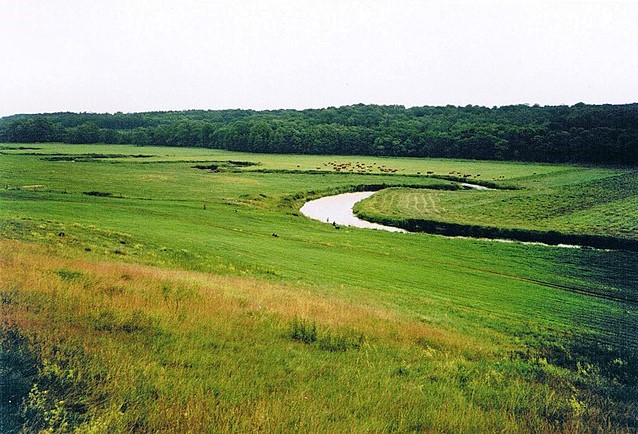
Spears, clubs, swords, knives, sickles and arrows were used during the battle. Many of the skulls (of which over 40 were found) show signs of battle wounds, with a bronze arrowhead found in one of them. By late 2017, about 50 bronze arrowheads had been found. Remnants of the arrows' wooden shafts provided a further possibility for dating with more than a third dating to the same time as the bones. Contrasting these arrowheads with others made from flint and with wooden clubs, it has been surmised that two differently-equipped groups confronted each other. No swords have been found so far, but bones show cutting traces typical for this type of weapon. Some combatants rode into battle as evidenced by horse bones (of at least five horses) found on site. The original arrowhead's position in the initially found humerus bone shows that an archer on foot wounded a horseman. Standardized metal weaponry was found intermingled with horse bones. These findings have led archaeologists to conclude that an officer class consisting of Bronze-wielding mounted warriors presided over the regular soldiers with simpler weaponry[5].
In 2016, scuba diving archaeologists found what was believed to be the contents of a toolkit belonging to one of the participants at the bottom of the river. A cluster of 31 Bronze artifacts was found on the river bed, with the items so close together that it was believed that they had once been in a box or bag which had since rotted away. The contents consisted of a Bronze knife with a curved blade, an awl decorated with ladders and rows of triangles, a Bronze chisel with wear marks, an assortment of Bronze scraps and ingots, and three tubes made of rolled Bronze. According to archaeologists, the pieces of scrap Bronze would likely have been used as currency in Bronze Age Europe in the absence of coins, and their presence suggested that the owner of the toolkit was not native to the area. Various artifacts found in the box suggested that its owner was from South-Central Europe and had traveled hundreds of miles to the battlefield[7].
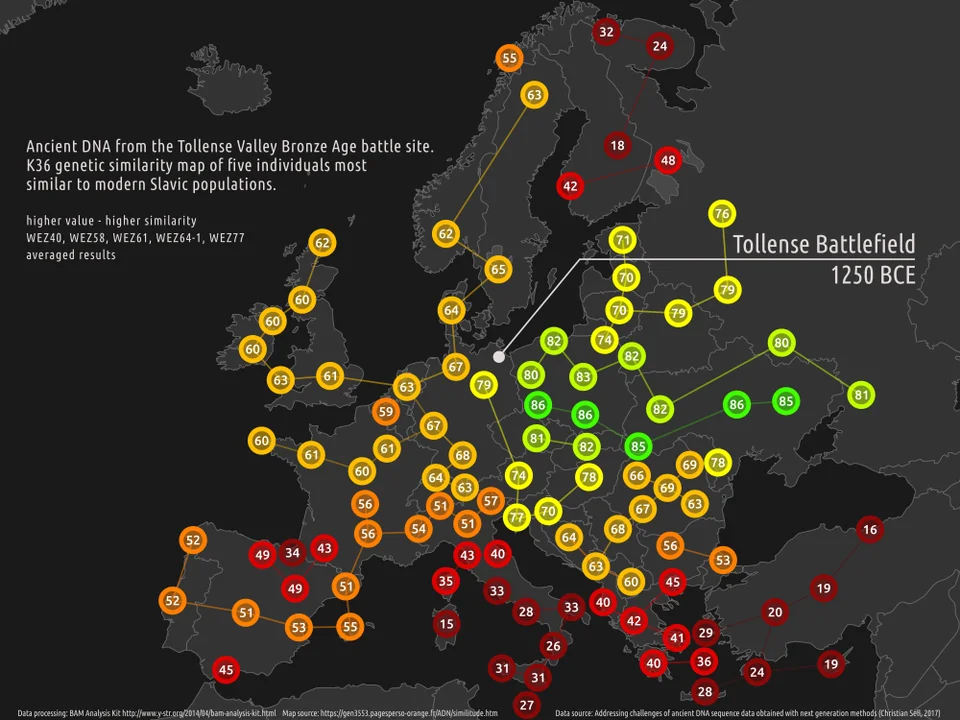
Populations most similar to five Tollense Warriors are marked in green
(data visualization by mapnik on CC 3.0)
The overseeing State Archaeologist Detlef Jantzen claims this to be the oldest archaeologically verifiable battlefield in Europe and one of the 50 most important find sites worldwide. He also said: "The Tollense site has a dimension that nobody would have deemed possible for our region." Helle Vandkilde, archeologist at Aarhus University commented "Most people thought ancient society was peaceful, and that Bronze Age males were concerned with trading and so on[...] Very few talked about warfare". A group of 5000 combatants implies that they had been gathered, organised, fed, briefed, and led into battle[5]. According to the researchers at the site, this would have been an astounding feat for the time, probably enabled by a central government. This would mean that socio-political development in Central Europe was more advanced and more bellicose than previously assumed, roughly at a time when Egypt and the Hittites concluded their famous peace treaty.
The well-preserved bones and artifacts add detail to this picture of Bronze Age sophistication, pointing to the existence of a trained warrior class and suggesting that people from across Europe joined the bloody fray[5].
Cult Wagons
The cult wagons (bird carts) appear in Europe around 1500 BC and are found in archaeological sites dating until 500 BC. On each discovered wagon there are two or three movable four-spoke wheels on one axle. Each wagon rests on a sleeve-shaped drawbar, with forks terminated with upright, highly simplified bird figures, with more or less exposed beaks and with transverse horns attached in most cases. In one case, there is no such attribute and chain is attached to the bird's beak (a cart from Pierstnica, Poland). The trolleys are often decorated with smaller, stylized figures of birds attached to vertical sticks, arranged in various symmetrical configurations on the drawbar or axle.
The complicated form of these constructions, requiring the use of multiple, complex casting processes proves, on the one hand, the craftsmanship of the manufacturers and, on the other hand, their refined aesthetic taste. The unique products in question date back to the Late Bronze Age (around 900 BC - 750 BC) and undoubtedly reflect the high level of civilization development of the communities inhabiting the Central Nadodrze area at that time[8].
Most of the carts are accidental finds, discovered individually without any other additional items, sometimes hidden in a clay vessel (in Eiche-Golm and probably in Kałowice). Only the Pierstnica wagons appeared together with two equally unique cuff bracelets (similar to one from 1300 BC burial in Trudshøj - Skallerup, Denmark), which gives this set the attribute of a treasure. The whole thing was placed in a pit within the cemetery located near the marshy area. Most of other finds probably come from the cemetery zone, although not as equipment for the graves, and one of the pieces from Burg, Germany was discovered in a peat bog, previously one of the places especially predestined for sacrificial deposits. Such locations clearly show the connection of these devices with funeral rituals or other cult practices[8].
When it comes to their use, a certain indication are the holes for rivets in the drawbar sleeves, which were used to bind the handle in the form of a wooden rod, which could suggest that the carts were rolled on the ground. However, the lack of visible signs of wear on the wheel rims evokes their alternative interpretations, maybe as separate equipment carried during ceremonies or processions, or an element clogged in a larger whole, for example on a wooden cart[8].
Trolleys from the central area of Nadodrze belong to a larger group of this type of equipment from the Bronze Age and the Hallstatt period, discovered in various regions of Europe and also associated with funeral practices. Among them, there are models carrying vessels, which, apart from the obvious symbolic dimension, could also play a practical role during religious ceremonies (transporting cremated remains; the function of a water cistern). Mostly bronze items have survived to our times, although clay carts were also made, which were certainly much more common[8].
One of more interesting recent disoveries in this matter is a large 1000 BC bronze drinking vessel adorned with similar bird symbols from the village of Kladina in Eastern Bohemia, Czech Republic. Traces of liquid that was stored in the vessel allowed archaeologists to reconstruct a 3000 year old drink, which turned out to be a type of herbal millet beer[9][10]. It might have been used during a funeral feast to ease the pain of the mourners.
In the spring of 1895, the owner of Trudshøj in Denmark began excavating the mound (kurgan, tumulus), which the National Museum had tried in vain to obtain for a compensation of 100 DKK. Under a 2 m high stone heap on the bottom of the mound were the remains of an approximately 4 m long wooden (oak) coffin, which the excavator had emptied of antiquities without the presence of the National Museum. The tomb contained a unique bronze vessel of Central European origin, a so-called cult wagon, a gold bracelet, a sword, a razor with a horse-shaped grip, a knife and tweezers, all made of bronze and highly fragmented, as well as remnants of wood, clothing, skins and horns. Inside the coffin stood the Skallerup's bronze wagon, which, however, had been crushed after the wooden (oak) coffin had succumbed due to its decay. The wagon (carriage boiler) contained the burned bones of the deceased. As early as 1896, a chemical analysis was carried out on the wagon, according to which the metal was an alloy of copper with tin and some other metals. It was made somewhere in the Eastern Central Europe and was thus an imported commodity[11].
Many razors of the Nordic Bronze Age also have crude depictions of what appear to be water birds, something again associated with the migration of souls and transformation in general. This was carried into the Viking age, where Valkyries are often described as wearing "swan armour". Even in the modern age we have the popular phrase "swansong" indicating the final or last of something. These razors could be used in the ceremonial slaughter of any animals or even people that were to travel with the deceased upon their journey[12][13].
The mute swan is also one of the sacred birds of Apollo (Luwian: "Apaliunas"), whose associations stem both from the nature of the bird as a symbol of light, as well as the notion of a "swansong". The god is often depicted riding a chariot pulled by or composed of swans in his ascension from Delos.
Swans are revered in Hinduism, and are compared to saintly persons whose chief characteristic is to be in the world without getting attached to it, just as a swan's feather does not get wet although it is in water[14]. The Sanskrit word for swan is hamsa and the "Raja Hamsam" or the Royal Swan is the vehicle of Goddess Saraswati which symbolises the "Sattva Guna" or purity par excellence. The swan if offered a mixture of milk (soma) and water, is said to be able to drink the milk (soma) alone. Therefore, Goddess Saraswati the goddess of knowledge is seen riding the swan because the swan thus symbolizes "Viveka" i.e. prudence and discrimination between the good and the bad or between the eternal and the transient. Swan is also a vehicle of her husband Brahma - the god with powers of creation, in Hindu trinity and his other wife Gayatri - the goddess of vedas(vedmata), one of Adi shakti. The hamsa is often identified with the Supreme Spirit, Ultimate Reality or Brahman in Hinduism. The flight of the hamsa symbolizes moksha, the release from the cycle of samsara[14].
The Hittites believed that a soul can be brought to the Netherworld (the Meadows; the Wellus) by a bee, a duck (when one died in the sea; actually "lahhanza"; maybe a stork), a swan (when one died in a river), an eagle (when one died in the sky; probably in the mountains). Then it had to cross the road through the great river or a pool to get to the meadow[15].
Maybe an explanation for those water birds does not have to be sought so far away from the Lusatian Culture itself. The pagan Slavic peoples thought that the birds flying away to Vyraj (Raj) before winter and returning to Earth for the spring are the human souls. According to some folk tales, the human soul departs the Earth for Vyraj during the cremation of its deceased flesh on a pyre. However, it does not stay in paradise forever, returning some time later to the womb of a pregnant woman (traces of reincarnation can be seen in this belief) — carried by a stork or a nightjar[16]. This idea was later simplified to "storks bring children into the world".
Ancient DNA in Central Europe
30% of male population in modern day Poland carries the Y-DNA haplogroup R1a-M458 , which came into existence around 2700 BC. Other subclades of R1a present in modern day Poland are R1a-Z92 and R1a-Z280. The R1a-M458 haplogroup descends from the R1a-Z283 (3500 BC) and then R1a-Z282 (3200 BC). People carrying its paternal haplogroup R1a-Z282 went to Scandinavia with the Corded Ware Culture expansion and there their descendants' Y-DNA evolved into a Scandinavian R1a-Z284 subclade, later found in the Nordic Bronze Age archeogenetic samples. The earliest such samples include a man from 2492 BC site in Kyndeløse, Denmark (R1a-Z284) and 2140 BC man from Olsund, Sweden (R1a-Z283).
All subclades of R1a mentioned above descend from the R1a-M417 haplogroup, which originated around 4500 BC. The oldest known sample of R1a-M417 comes from a cemetery of the Sredny Stog II Culture near Kupyansk, Ukraine and it is dated to 3500 BC. Nowadays almost 60% of all Polish men carry a subclade of R1a-M417.
While R1a originated from 22000 to 25000 years ago, its subclade R1a-M417 (R1a1a1) diversified into R1a-Z283 and R1a-Z93 about 5800 years ago (3800 BC). The R1a-Z93 separated from the R1a-Z283 in the region of Carpathian Mountains, Southern Poland and Western Ukraine. The earliest known sample of the R1a-Z93 (still without R1a-Z94 mutation) was dated to 3500 BC - 3000 BC and comes from the Glăvănești Iași (Glavanesti Iasi) in Romania near the border with Moldova. Then the R1a-Z93 moved to the Fatyanovo-Balanovo Culture around 3000 BC - 2300 BC and then their descendants formed the Sintashta Culture and the Andronovo Horizon. Their language evolved into Avestan and Sanskrit languages around 1500 BC.
There are several ancient DNA samples related to the Corded Ware Culture available, for example:
RISE00 - Corded Ware sample from Estonia (from Sope, 2575 BC - 2349 BC, mtDNA: H5a1)
RISE431 - Early Unetice from Poland (Łęki Małe / Bruszczewo)
RISE395 - Sintashta from Russia (Bol'shekaraganskii)
RISE386 - Sintashta from Russia (Bulanovo near Orenburg)
RISE394 - Sintashta from Russia (Bulanovo near Orenburg)
RISE392 - Sintashta from Russia (Stepnoe VII near Troitsk)
Nearly all of these samples (including Łęki Małe from Poland) plot within modern North Slavic continuum (The samples of modern ethnic Poles were not included in the comparisons). Only RISE392 (Sintashta) and Andronovo are closer to modern ethnic Mordvins and ethnic Russians from Kargopol. The remaining samples cluster with modern Belarusians, Western Ukrainians and Eastern Ukrainians. Sample from Estonia (RISE00) is intermediary between modern Belarusians and Estonians[17].
 According to a study from 2020 by Papac et al. the first R1a-M417 (R1a-Z645) appeared in Bohemia, Czechia around the year 2750 BC and in the next 500 years became widely spread through a selective clan mating[18]. A male who carried the R1a-M417 haplogroup in Bohemia in his autosomal and Y chromosome DNA resembles males from the Bronze Age Latvia and males from the later Unetice Culture. Another haplogroup common in Bohemia around the same time was the R1b-L51 haplogroup ancestral to West Europeans and Italians[18].
According to a study from 2020 by Papac et al. the first R1a-M417 (R1a-Z645) appeared in Bohemia, Czechia around the year 2750 BC and in the next 500 years became widely spread through a selective clan mating[18]. A male who carried the R1a-M417 haplogroup in Bohemia in his autosomal and Y chromosome DNA resembles males from the Bronze Age Latvia and males from the later Unetice Culture. Another haplogroup common in Bohemia around the same time was the R1b-L51 haplogroup ancestral to West Europeans and Italians[18].
According to a study from 2007, around 34.2% of Czech men belong to the Y-DNA hapgloroup R1a[19]. Within the Czech Republic the proportion of R1a seems to gradually increase from West to East. According to a study from 2000, around 35.6% of Czech men carry the R1b haplogroup. The Western part of Czechia did not belong to the Lusatian Culture but its Eastern part - Moravia did. The Western part was mainly dominated by Celts (R1b) of the Hallstatt Culture and later in history by Germanic invaders. 38% of men in Slovakia carry the R1a-M417 haplogroup while only 13% carry the R1b+ haplogroup, I2a is 18%.
Nowadays Czechs do not carry much R1a-Z280, a factor that strongly differentiates them from their Slovak, Hungarian and Slovene neighbours. Czech R1a belongs in majority to R1a-M458, with its subclades such as YP654 (TMRCA 200 BC), YP1703 (TMRCA 200 CE), Y2905 (TMRCA 200 CE) and YP1337 (TMRCA 250 CE). Other R1a clades found in the Czech Republic include YP951 (from R1a-Z280, TMRCA 500 BC), YP4278 (from R1a-Z280, TMRCA 150 CE), some R1a-Z92 and R1a-Z93, as well as Sacandinavian and Bell Beaker Culture related R1a-L664.
Polish Copper Age and Bronze Age samples starting around 3000 BC carry Indo-European Y-DNA lineages R1. A man from Obłaczkowo in Greater Poland dated to 2865 BC - 2578 BC already carried R1a-Z280 (descended from R1a-Z282 and earlier R1a-Z283). Three men from the Bell Beaker Culture from Samborzec in Lesser Poland dated to 2400 BC - 2200 BC carried R1b1a1a2 (R1b-M269). Two men from Rogalin near Hrubieszów dated to 1900 BC - 1615 BC carried R1a1a1 (R1a-M417+). A man from Gustorzyn in Kuyavia, Poland dated to 1953 BC - 1880 BC carried R1a1a1b1a2c (R1a-S24902, a subclade of R1a-Z280). Today up to 1% of Poles belong to the same lineage of R1a1a1b1a2c (R1a-S24902). A popular actor Max von Sydow, whose paternal ancestor David Sydow was born in Pomerania before 1724 CE, belonged to R1a-Z280 (Pomeranian R1a-P269 subclade).
Two Copper Age men from Jagodno in Lower Silesia, Poland dated to 2800 BC carried Neolithic Y-DNA lineages G and I2. They possibly descended from the people of Globular Amphora Culture. Łęki Małe in Greater Poland was a Kurgan Cemetery of either Late Corded Ware or Proto-Unetice people. Corded Ware Culture people were a hybrid of Proto-Indo-Europeans from the Pontic-Caspian Steppe and local Neolithic Farmers. The Unetice Culture existed in Western Poland during much of the Bronze Age (around 550 sites) and is often associated with Proto-Celts or Proto-Italo-Celts. This could be the reason why there are still words related to Latin in modern day Polish language. For example a pigeon in Latin is: columba (golumba) and in Polish: gołąb (golomb, golamb), both keep the nasal sound "um" and "an" - "on".
A male from Łęki Małe kurgan number 4 (RISE431) near Poznań, Poland from an earlier Unetice Culture (1700 BC - 1500 BC) carried mtDNA T2e and Y-DNA R1a1a1 (R1a-M417) haplogroups. The amount of mtDNA T2b haplogroup is around 7% in modern day population of Poland. The amount of T1a and T2 combined in the Yamna Culture was 14.5%, so slightly higher. The Łęki Małe kurgan cemetery was also used by people from a nearby fortified settlement Bruszczewo (established 2300 BC). Later it became one of the bigger settlements of Lusatian Culture (similar to Biskupin).
It has now turned out that communities several hundred years younger (the Mierzanowice and Trzciniec cultures) exhibit genetic continuity (associated with the Corded Ware Culture) present in the female lines. Members of communities related to the Mierzanowice, Strzyżów and Trzciniec cultures (which all existed from 2400 BC to 1100 BC) genetically resembled population of the Yamna Culture and the Corded Ware Culture[20].
Some Unetice Culture groups later evolved into early Lusatian Tumulus Culture (1700 BC - 1400 BC), originally located between the Elbe and Oder river basins, which later expanded East (1300 BC - 500 BC) into territories of previous Trzciniec Culture. The diffusion of West Indo-European isoglosses has already been proposed to be identified with the Unetice expansion into peoples of mixed ancestry and lineages, and continuity of such admixture from the region of early Lusatian into Urnfield-Lusatian cultures is supported by findings of R1a-Z282 lineages in the Urnfield group from Saxony-Anhalt, close to the proto-Lusatian original territory. That points to the Elbe basin as the original site of cultural breach for R1a-Z282 lineages, between the older Corded Ware tradition and the new Unetice Culture and language[21].
Three out of sixteen males tested from the 1250 BC Tollense Valley battlefield carried the Y-DNA haplogroup R1b-P312 (already common among Bell Beakers, for example found in a sample from Quedlinburg, Germany around 2296 BC), two males carried the R1b-L51 haplogroup and one carried the R1b-M269 haplogroup. Nine males carried the I2a-M223 Y-DNA haplogroup, while the WEZ56 individual (sunken deep in the river) carried the R1a-Z283 haplogroup. The tests were conducted by Joachim Burger.
2015 study by Cassidy et al. showed that two Hungarian Bronze Age samples (NE1, BR2 - 1200 BC Ludas-Varjú-dulo, Hungary) from around 1200 BC when compared to modern aDNA of populations from Europe produce a heatmap with most affinity to the area of Poland (highest value), Italy and Wales. The Neolithic samples from Hungary clustered with Greece, Siciliy and Italy[22].
There were 40 skeletons discovered in Lichtenstein Cave (Lichtensteinhöhle) in Germany and dated to around 1000 BC. Both mitochondrial DNA and Y-chromosome DNA tests were conducted on the skeletons and published by the University of Göttingen. Mitochondrial haplogroups found included 17x H, 5x T2, 9x U5b and 5x J*. Out of 19 males represented in the cave, 15 yielded the full 12 tested STR values, with twelve showing haplotypes related to Y-DNA haplogroup I2b2 (at least four lineages), two to R1a (probably one lineage), and one to R1b1c9 (R1b-S21)[23].
Those Y-DNA haplogroups nowadays appear mostly in countries speaking Germanic languages, including Norway, Sweden, Denmark, Netherlands, England and Germany. Those samples were found close to the Western border of the Lusatian Culture and already around 1000 BC were not part of its cultural area (cremation practice for example). Those people could be associated with the Knoviz Culture or Lower-Rhine Urnfield Culture. Most probably the latter because Knoviz Culture practiced cremation[24] and would not leave behind the buried human bones, unlike the Nordic Bronze Age and some Lower-Rhine related burials.
The genetic conclusions
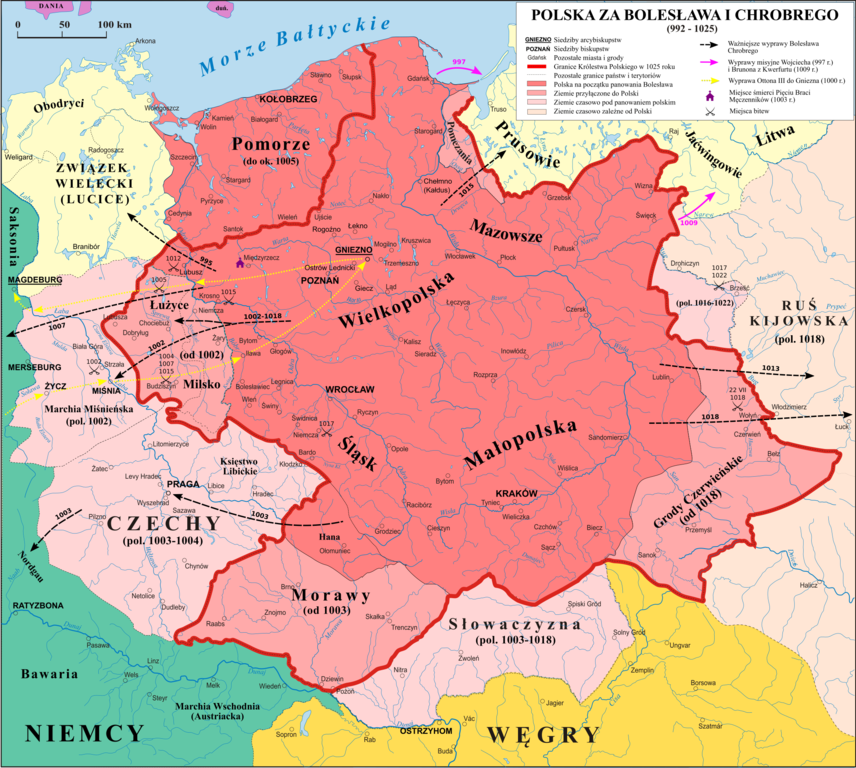
It can be concluded that the origins of the Slavs go back to circa 3500 BC with the Northern Yamna Culture and its expansion across Central and Northeast Europe with the Corded Ware Culture. The R1a-M458 and R1a-Z280 lineages spread around Poland, Belarus, Ukraine and Western Russia, and would form the core of the Proto-Balto-Slavic culture.
The Slavic branch of the Indo-European languages most probably differentiated itself around 3000 BC, when the Corded Ware Culture absorbed the Cucuteni-Trypillia Culture (5200 BC - 2600 BC) of Western Ukraine and Northern Romania. The Cucuteni-Trypillia appears to have been composed primarily of G2a-U1 and I2a1b-M423 lineages, which descended directly from the Paleolithic Europeans, with some other Middle Eastern Farmer lineages (notably E-V13, J2a and T1a). It is surely during this period that I2a1, E-V13 and T spread (along with Corded Ware Culture R1a) around Poland, Belarus and Western Russia, explaining why Eastern and Northern Slavs (and Lithuanians) have between 10% and 20% of I2a1b lineages and about 10% of Middle Eastern E-V13, G2a lineages (18% for Ukrainians)[25].
The most common haplogroup among Slavic and Baltic people is R1a-Z280 and it was already present in the Trzciniec Culture and observed in the Lusatian Culture (1880 BC male from Kuyavian Gustorzyn carried a subclade of R1a-Z280)[26]. The other common Balto-Slavic haplogroup, namely R1a-Z92 spread mainly in the Northeastern Europe near Lithuania. Another haplogroup R1a-CTS1211/R1a-M558, which originated around 2400 BC from R1a-Z280, is present from Alps to the Volga river.
The percentage of East Slavic and Baltic R1a-Z92 (descended from R1a-Z280) is 13% in Belarus, 10% in Lithuania, 10% in Western Russia, 6% in Ukraine, 5% in Poland, 3% in Slovakia and Romania, 1% in Czech Republic. If Slavs would migrate from the East near the Pripet river only in the 6th century CE then we would see a much higher percentage of R1a-Z92 in Poland, Czech Republic and Slovakia when compared to Belarus, Ukraine and Western Russia.
For example, the R1a-L260 subclade is only found in Poland, Czech Republic and Slovakia. This proves a long-term stability of living in a given area by the same genetic human population. This subclade does not exist in Eastern Europe so again it could not be brought towards West by the Eastern migration. It originated around 800 BC from the R1a-M458 haplogroup, which itself formed around 2800 BC from the R1a-Z282 haplogroup.
In Silesia, Poland R1a-M417 divides into subclades in a following manner: 42% of R1a-M458 (purely West Slavic), 22.8% of R1a-Z280 (Balto-Slavic), 14% of R1a-M198 (7700 BC in Siberia, probably marked without deep subclades), 12% of R1a-M512 (10000 BC from Siberia), 9% of R1a-Z93 (Scythian or Sarmatian or from 3500 BC people near Carpathian Mountains who stayed in this region instead of moving into Asia).
In the Urzecze region of Poland the R1a Y-DNA makes up 60% of all haplogroups and it divides into subclades in a following manner: 16% of R1a-L1029 (TMRCA 500 BC; from R1a-M458), 16% of R1a-YP256 (from R1a-M458), 13% of R1a-S18681 (from R1a-M458), 11% of R1a-YP515 (from R1a-M458), 11% of R1a-Z280, 8% of R1a-L1280 (from R1a-CTS1211/R1a-M558), 5% of R1a-YP237 (from R1a-Z280 and R1a-CTS1211), 5% of R1a-Y2608 (from R1a-Z280 and R1a-CTS1211), 1% of R1a-Y2902 (from R1a-Z280 and R1a-CTS1211), 1% of R1a-P278.2 (from R1a-Z280 and R1a-CTS1211), 1% of R1a-Y17491 (from R1a-Z282), 1% of R1a-Y2604 (from R1a-M458)[27].
In total 57% of all R1a from the Urzecze region of Poland descends from the R1a-M458 Y-DNA haplogroup and 43% from either R1a-CTS1211 (R1a-M558) or its deeper R1a-Z280 clade. R1a-Y2613 from R1a-CTS1211 (R1a-M558) appears already around 1873 BC in an individual I6185 from Trestiana, Romania; he also carried the mtDNA U2e1b[28].
The remaining haplogroups found in the Urzecze region, Poland are: 9% of R1b (mainly R1b-U106 - mostly found in Austria, Jutland and Netherlands), 8% of E1b-M35.1 (Early European Farmer related; common in Greece, Albania and Serbia), 5% of I1 (Scandinavian Hunter-Gatherer), 5% of I2a-P37.2 (I2a1a; TMRCA 6000 BC), 4% of I1-Y6343 (from I1a1a1; not unusual for Poland), 3% of N1c (Uralic, Finnic), 2% of J2b (Early European Farmer; common in Greece, Albania and Serbia), 1% of Q (related to Native Americans, ANE and Saami), 1% of G2a (CHG and GAC related), 1% of I2a2a (I2a-M223)[27].
According to a study from FamilyTreeDNA conducted on 232 Polish-Lithuanian families from nobility 22.4% of them belonged to Y-DNA haplogroup R1a-M458 and 25% to R1a-Z280, 1.7% to R1a-Z93 and none to R1a-Z284 (Scandinavian). Almost 6.5% also belonged to R1b-P312, 2.2% to R1b-U106 and 0.9% to R1b-Z2103. There was also Uralic (post 500 BC) N1c-L550 detected in 10.3% of all samples and I2a1-CTS5996 in 8.6% of all samples. Polish-Lithuanian nobility lacks the Y-DNA haplogroups: D (Tibetan), H (Dravidian), J1 (Arabic), L (Pakistani, Dravidian, Elamite), T (Georgian, Near Eastern), O (Chinese)[29].
It was found that the peoples of the Corded Ware Culture, Bell Beaker Culture, Unetice Culture and Nordic Bronze Age were genetically very similar to one another, and displayed a significant amount of genetic affinity with the Yamnaya Culture.
Image credits in the Lusatian Culture collage icon image:
"Tollense Battle" by Felix Abraham
"Bronze pin from Budziszewko" by Poznań Museum
Map in the Genetic Conclusions section: "Polska 992 - 1025" by Poznaniak and Popik on CC 3.0
Article created between the 30th of January 2021 and 14th of February 2021. Ten new images added on the 5th of May 2021. Whole DNA section updated on the 21st of June 2021 and 30th of October 2021. New map of major Lusatian Culture settlements created and added on 5th of Novemeber 2022.

